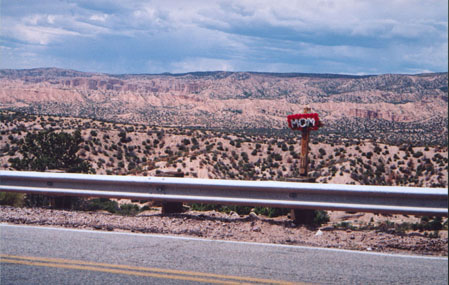 |
Making Space on the Side of the Road: Towards A Cultural Study of Roadside Car Crash Memorials
With Words and Pictures by Bob Bednar |
 |
Making Space on the Side of the Road: Towards A Cultural Study of Roadside Car Crash Memorials
With Words and Pictures by Bob Bednar |
Performance, for me, functions as an episteme, a way of knowing, not simply an object of analysis.
Diana Taylor, The Archive and the Repertoire: Performing Cultural Memory in the Americas (2003)
Back at home, I continually watch the paper for new deathsites to contemplate and photograph. In October, as I am finishing my paper for ASA, two separate groups of high school students in small towns south of Austin are involved in car crashes seven days apart. In the first, five kids die near Lockhart as the driver of the car overcorrects while steering around an Igloo Cooler sitting in the middle of the highway. In the second, a car plows into a high school cross-country team kneeling and praying on the roadside before their regular Saturday morning run. One runner is killed. Both stories run on the front page of the Austin paper. The second runs just above a story about how a disproportionate number of troops dying in Iraq are from small towns.
As with the space of fieldwork, here also I feel torn between the pain of imagining the actual losses for the families pictured in the paper and the excitement that I will have another site to explore. It's getting ghoulish, really.
The paper quotes Dale Guzman, one of the cross-country team members who was injured:
Guzman said he feels lucky to be alive, though sad that one of his teammates didn't survive. "He was one of our better runners and he was a good friend. I remember yesterday being in class with him . . . and the next day, in the blink of an eye, he's gone," he said.
In the blink of an eye. It seems an apt metaphor: Car crashes are so sudden that the victims and those who grieve the victims don't have time to process them. My guess is that no one who dies accidentally--not even a drunk driver--thinks it is going to happen to them until it is too late. Maybe that's why people construct roadside memorials: for those left to live and live with the story to have a place to physically embody their grief over time. But why on the roadside, and not in the home, or at the cemetery? Such a site could be (and often is) constructed in the homes of the survivors and at cemeteries, but the existence of ostensibly private memorials in public space shows that the people who made it want to remember publically. A roadside memorial not only says "I remember you, and I will remember you," but also "I want the community to remember you."
A final moment...
I'm in New Mexico. I'm photographing another MOM site. This one is just a few miles from where we were camping for a couple of days, taking a break from the road. Part of the memorial is attached to the guardrail, and part is set just outside it.
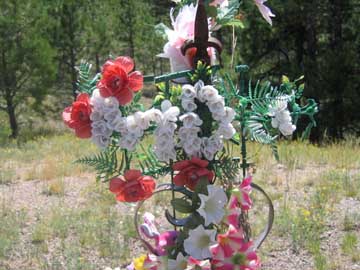 |
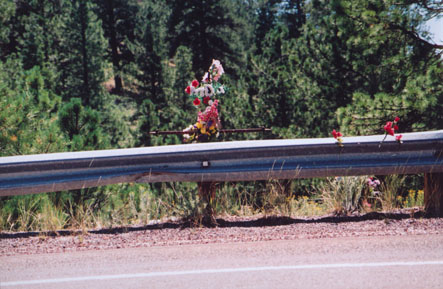 |
The cross carries the name, "Martha Martinez." The guardrail has a nasty dent in it. Is that from the crash?
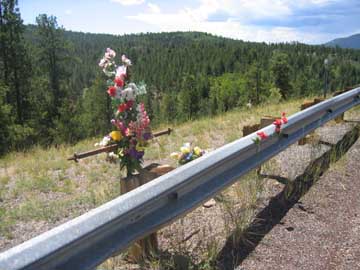 |
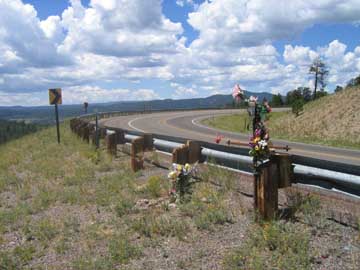 |
I'm moving around the site when something catches my eye: a child's handprint in the concrete holding up the memorial. The handprint is surrounded by several names. I assume that they are her children, the people for whom "Mom" means "My Mom." I move closer, feeling compelled to place my hand near it--for scale and for connection.
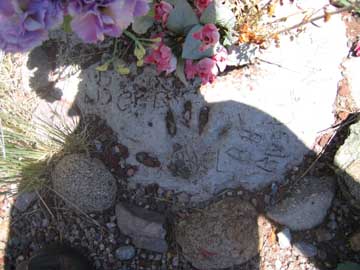 |
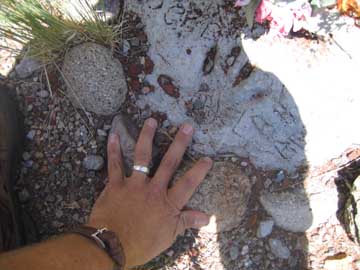 |
I glance back at the car, which is idling on the shoulder up the road at the next safest pullout spot. Anika is napping and Danielle is sitting in the backseat next to her. I had to slip out of the window of the driver's side door to avoid waking Anika up with a beeping door.
I frame a photograph with the cross and the car together. Would I want Danielle and Anika to put up a memorial if I died taking this picture? What would I hope it "said" about me? What would it look like? How would their site be related to the existing one in the same exact place? What if they were hit in our parked car and died while I was out of the car taking pictures? Would I create a memorial? How would I mark the space? What would it look like? Would I answer these questions differently if it happened closer to home, where I could visit more often? What if we all died?
Standing there on the side of the road, witnessing yet another deathsite, I see that these are not idle questions...
All Design, Photography, and Text © 2004
by Bob Bednar
Department of Communication Studies
Southwestern University
Georgetown, Texas 78626
(512) 863-1440
bednarb@southwestern.edu